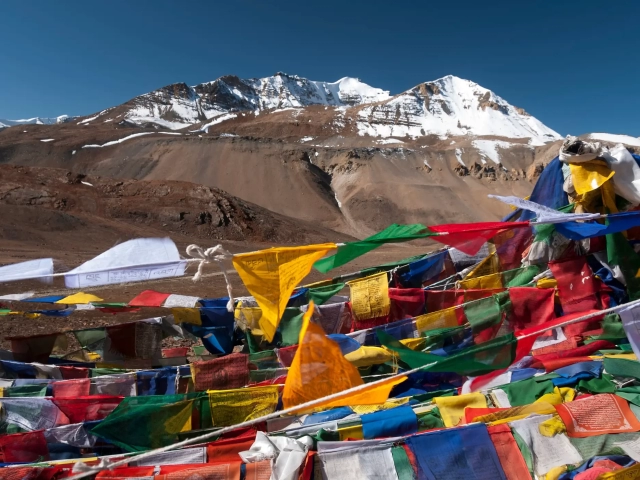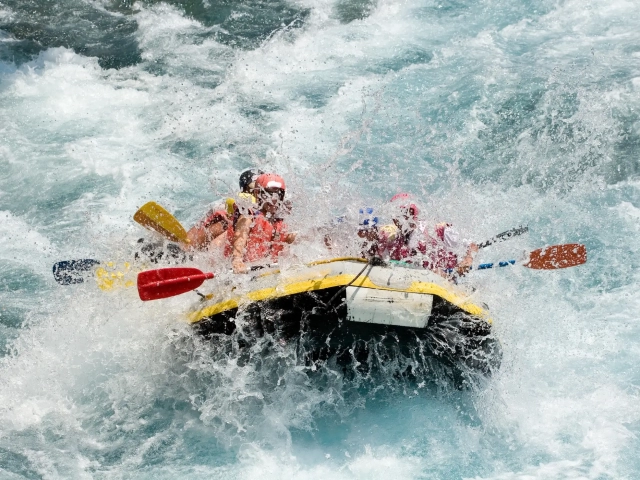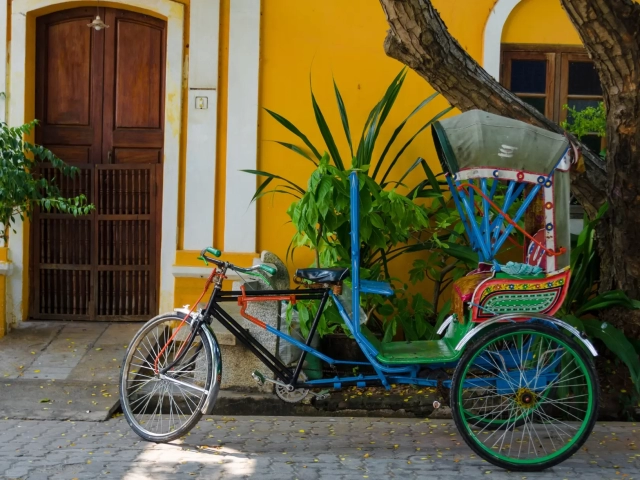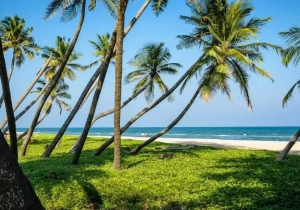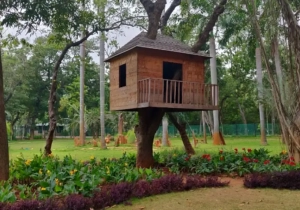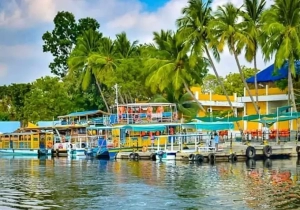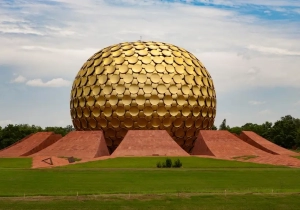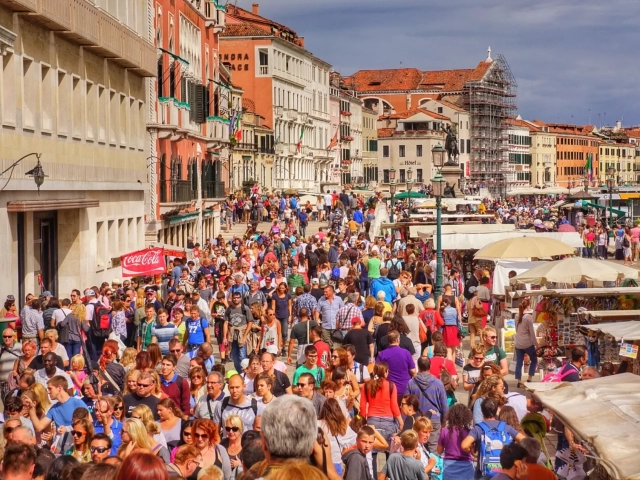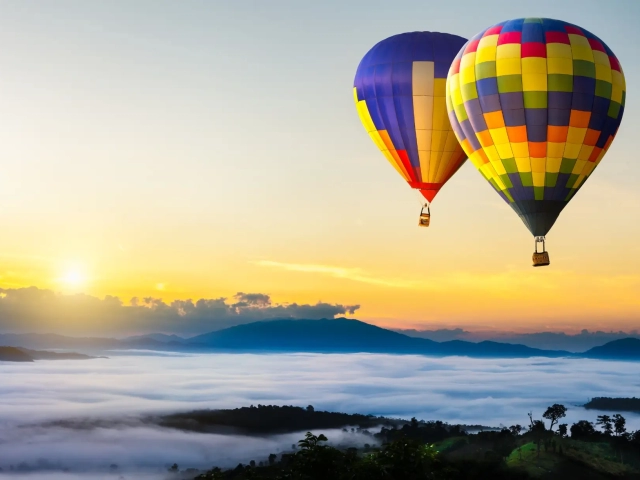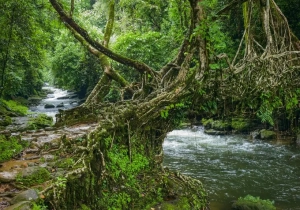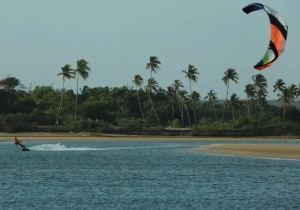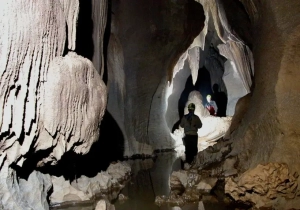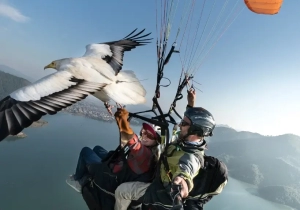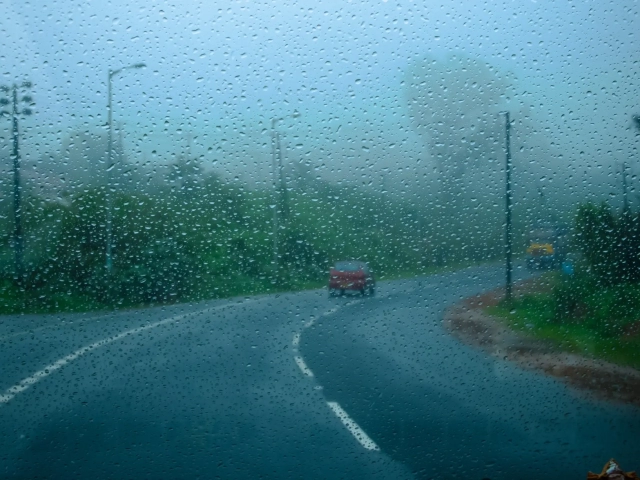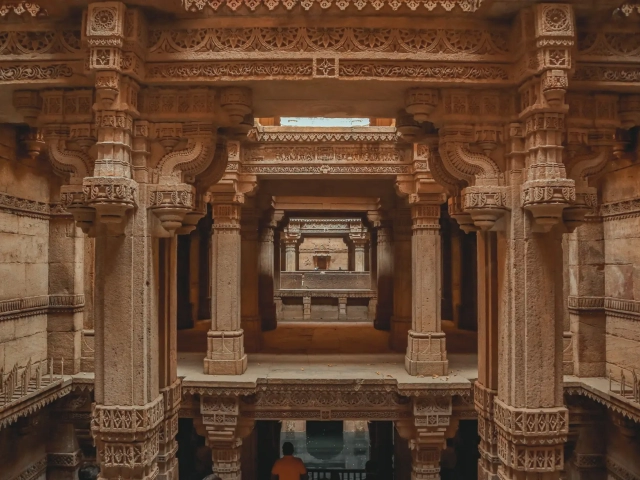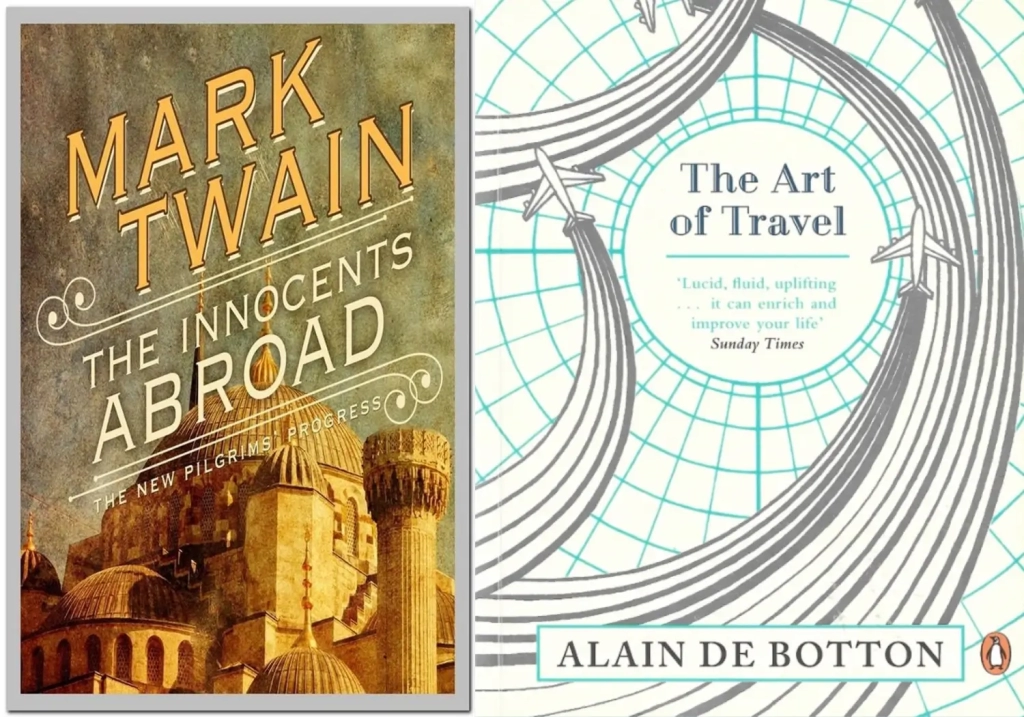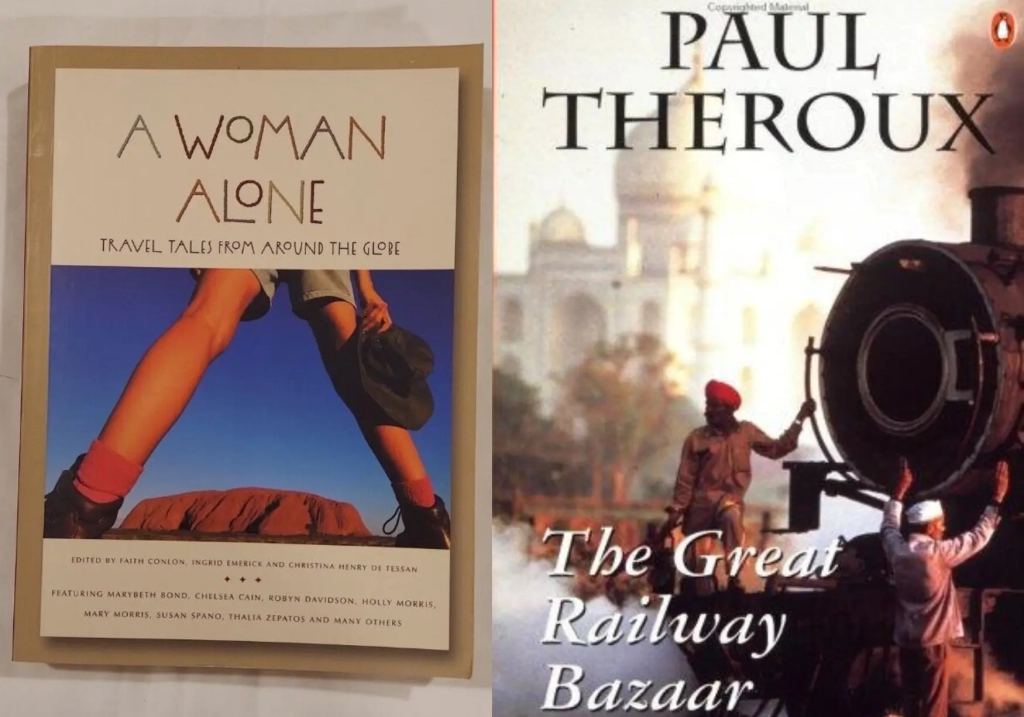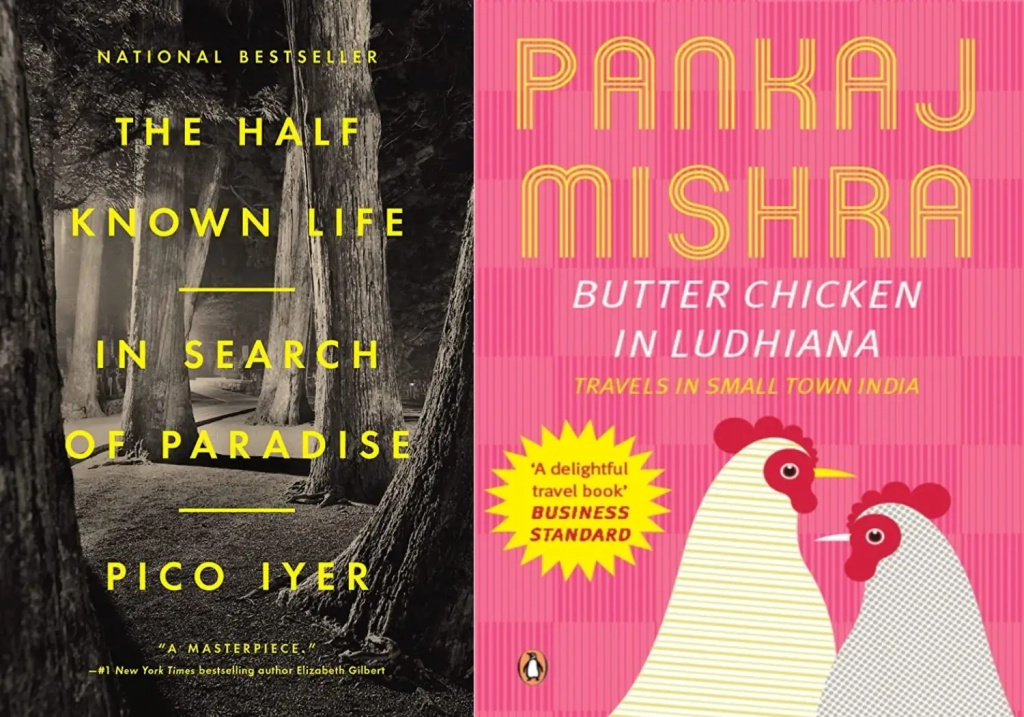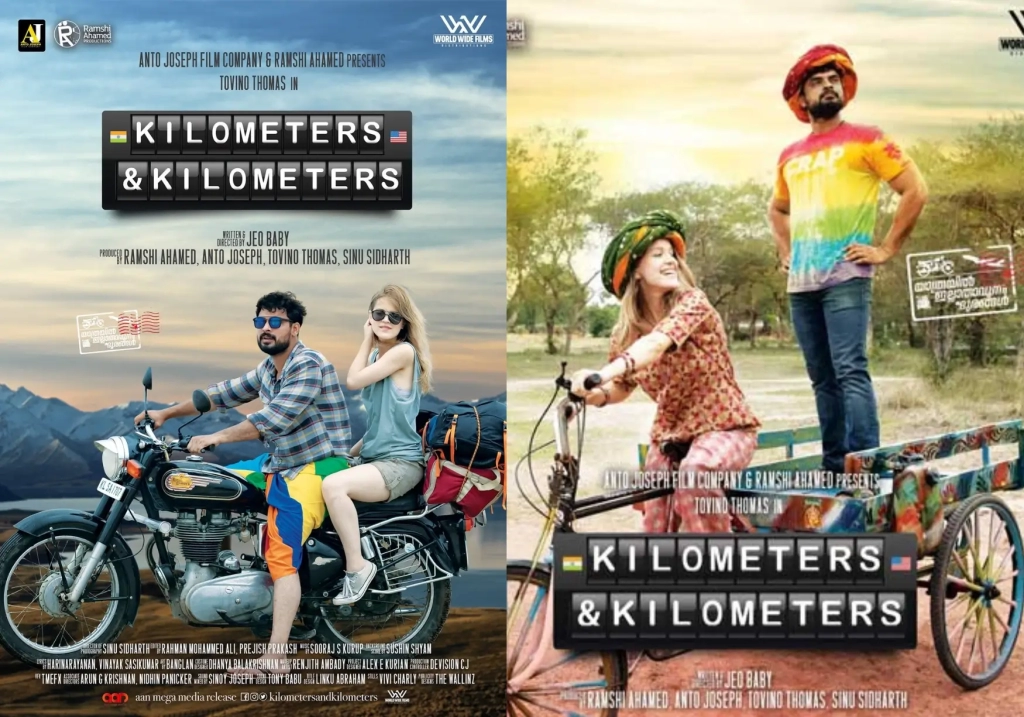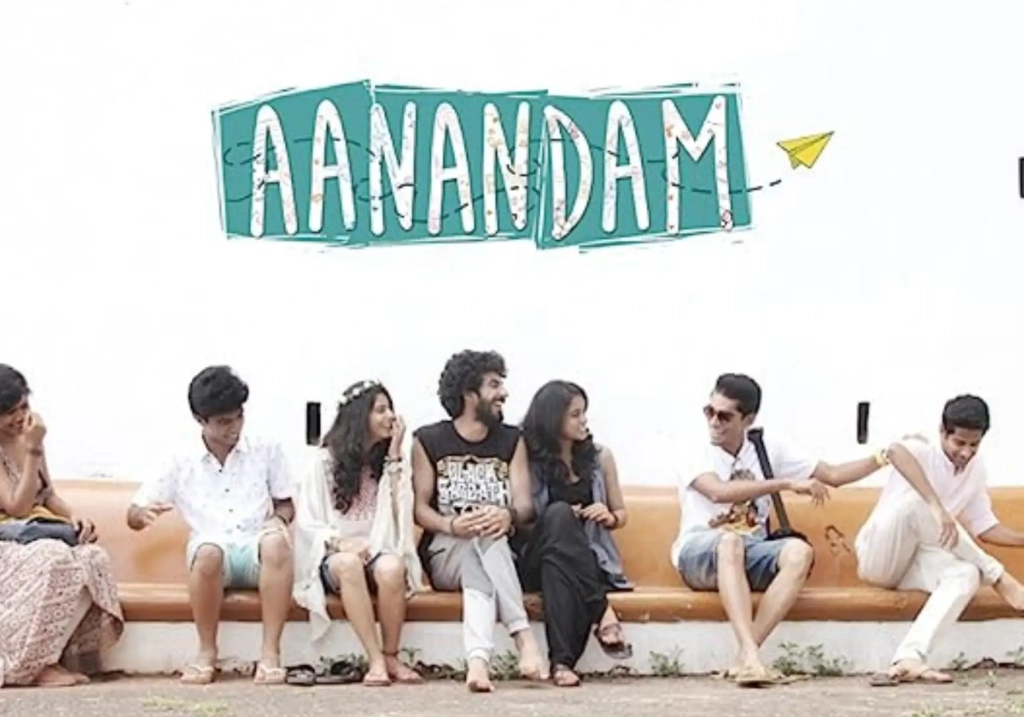Gangtok and East Sikkim
The capital city of Sikkim and the gateway to the state, Gangtok is known for its vibrant markets, monasteries, and breathtaking views of the Himalayas.
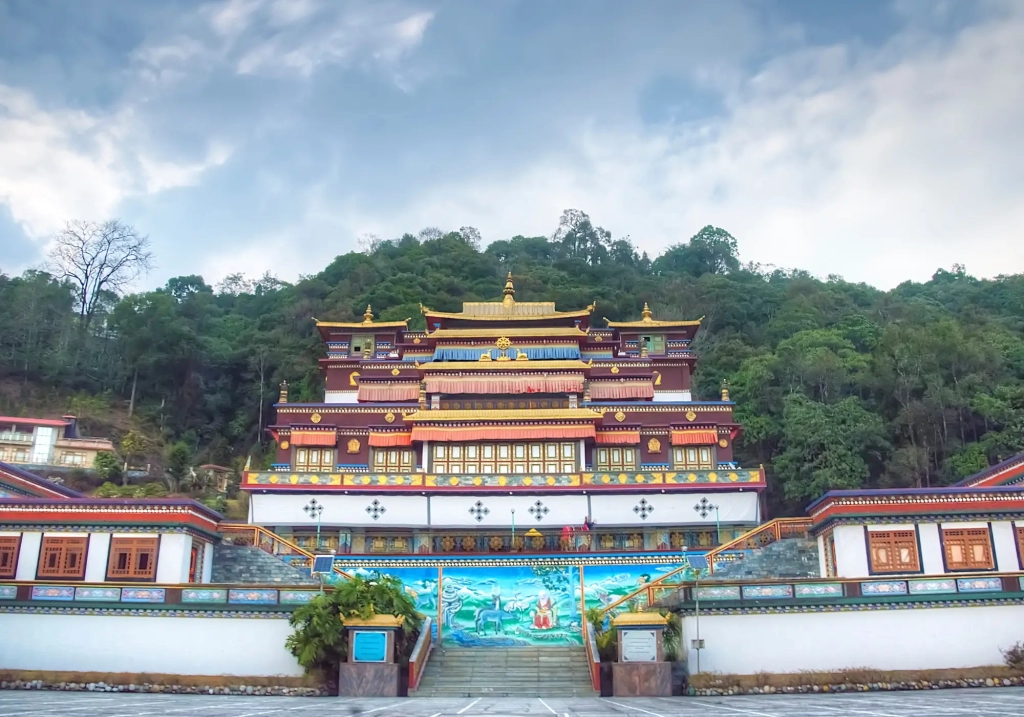
How to Reach Gangtok
By Air: The nearest airport to Gangtok is Bagdogra Airport, located in the neighboring state of West Bengal. Bagdogra Airport is well-connected to major cities in India, including Delhi, Kolkata, Mumbai, and Bangalore. From Bagdogra Airport, you can hire a taxi or take a pre-paid taxi service to reach Gangtok. The airport is approximately 125 kilometers away from Gangtok, and the journey takes around 4-5 hours, depending on road conditions.
By Train: The nearest major railway station to Gangtok is New Jalpaiguri Railway Station (NJP), also located in West Bengal. NJP is well-connected to various cities across India. From New Jalpaiguri Railway Station, you can hire a taxi or take a shared jeep to reach Gangtok. The railway station is approximately 120 kilometers away from Gangtok, and the journey may take around 4-5 hours, depending on road conditions.
By Road: Gangtok is well-connected by road to major cities and towns in Sikkim and neighboring states. If you are traveling from Bagdogra or NJP, you can hire a taxi or take a shared jeep from these locations to reach Gangtok. The road journey from Bagdogra or NJP to Gangtok may take around 4-5 hours, depending on the traffic and road conditions.
By Helicopter (Seasonal): During certain times of the year, the Sikkim Tourism Department operates a helicopter service between Bagdogra Airport and Gangtok. The helicopter ride offers breathtaking aerial views of the mountains and takes approximately 30 minutes to reach Gangtok
Places to visit
MG Marg: MG Marg, the pedestrian-only main street of Gangtok, is surrounded with stores, cafes, and dining establishments. It’s the ideal location for strolls and souvenir shoppings. Visitors are treated to a delightful culinary tour, enjoying both regional specialties and cuisine from around the world. The road is decorated with vibrant flowers that beckon tourists to take leisurely strolls, go shopping for trinkets, and become acquainted with the local way of life. MG Marg is a must-see stop on every Sikkim itinerary because of its buzzing energy, lively atmosphere, and abundance of activities. It is a monument to Gangtok’s charm.
Enchey Monastery: Located on a hilltop, this 200-year-old monastery is known for its intricate murals and religious artifacts. Surrounded by lush greenery, the monastery offers a tranquil and spiritual ambiance, making it an ideal place for meditation and introspection. It holds immense significance during the annual Cham Dance festival, where masked monks perform traditional dances to ward off evil spirits and bring blessings to the devotees. Enchey Monastery’s picturesque location and cultural importance make it a captivating destination for both spiritual seekers and tourists alike.
Rumtek Monastery: A major Buddhist pilgrimage site, Rumtek is one of the most significant monasteries in Sikkim. It showcases stunning architecture and houses precious religious relics. The monastery’s beautiful Tibetan architecture, vivid murals, and astounding holy artefacts are what give it its majestic appearance. A priceless and historic Black Hat that allegedly belonged to the 16th Karmapa is kept in the main shrine. Travellers and pilgrims come to Rumtek in search of spiritual peace and to take in the serene atmosphere of the area around the monastery. Visitors come from all over the world to the annual Kagyed Dance Festival, which is celebrated during the Tibetan New Year, to see the vibrant masked dances performed by monks and represent the victory of good over evil.
Tashi Viewpoint: Offering panoramic views of the snow-capped Kanchenjunga range, Tashi Viewpoint is a popular spot for photography and witnessing sunrise and sunset. This popular viewpoint is known for providing mesmerizing views of the Himalayan peaks and the picturesque Gangtok valley below.
Hanuman Tok: A temple dedicated to Lord Hanuman, Hanuman Tok provides stunning vistas of Gangtok and the surrounding mountains. Visitors must climb a short flight of stairs surrounded by lush vegetation in order to reach the temple. Once inside the temple, the calm atmosphere and view of the city below offer a tranquil escape from the hectic daily life. A lot of people come here to pray and to take in the spectacular views, especially at sunrise and sunset.
Banjhakri Falls: A serene waterfall surrounded by lush greenery; it also features a theme park showcasing traditional Sikkimese culture. Near Gangtok, there is a picturesque waterfall called Banjhakri Falls that is surrounded by luxuriant vegetation and stunning scenery. The falls are named after “Banjhakri,” which is a native term for a “jungle shaman” or “forest deity” and refers to the waterfalls. The location also has a theme park that uses sculptures and other works of art to highlight Sikkimese culture.
The park, which features footbridges, beautifully maintained gardens, and ancient tribal houses, is perfect for leisurely walking for visitors. The calm atmosphere created by the cascading waterfall makes it the perfect location for relaxation.
Ganesh Tok: Another viewpoint offering breathtaking views of the city, Ganesh Tok is also home to a small temple dedicated to Lord Ganesh. Visitors must climb a short flight of stairs through a deep forest to get to Ganesh Tok, which creates a calm and tranquil atmosphere. The temple’s small size contributes to its attractiveness by giving followers a quiet place to pray and find peace.
Do Drul Chorten: Do Drul Chorten, also known as Stupa of Do Drul Chorten, is an iconic Buddhist stupa located in Gangtok, Sikkim. The stupa is adorned with meticulously carved prayer wheels, each inscribed with sacred mantras, which devotees and visitors spin in a clockwise direction, believing it brings spiritual merit and blessings. The stupa’s white dome and golden spire stand out against the surrounding greenery, creating a serene and spiritually uplifting atmosphere.
Namgyal Institute of Tibetology: The Namgyal Institute of Tibetology is a renowned research facility and museum devoted to the study and preservation of Tibetan culture, history, and Buddhism. It was established in 1958 and is named for Sir Tashi Namgyal, the 11th Chogyal (royal) of Sikkim, who generously funded its founding. An outstanding collection of Buddhist artefacts, antiquated books, and traditional thangka paintings can be found in the institute’s museum. Exhibits on Tibetan iconography, iconography, and religious practises are available for visitors to explore, giving them a thorough insight of Tibetan heritage.
Saramsa Garden: A beautiful botanical garden showcasing a variety of flora, it’s an ideal spot for nature lovers. Wander along well-kept paths, take in the clean mountain air, and take in the peace and quiet of the surroundings. The garden’s tranquil atmosphere makes it the perfect place for leisurely strolls, picnics, and quiet moments of reflection. The Saramsa Garden also functions as a hub for horticultural research, displaying diverse horticultural techniques and methods for plant multiplication. Photographers and anyone who enjoy the outdoors enjoy photographing the garden’s vibrant colours and picturesque splendour.
Gangtok Ropeway: Enjoy a thrilling cable car ride that offers stunning views of Gangtok and the surrounding hills. Passengers get magnificent views of the charming Gangtok valley and the majestic Himalayan mountains as the cable car ascends. The journey offers a distinctive viewpoint of the city’s scenery, including the humming marketplaces, serene monasteries, and verdant vegetation. For visitors looking for adventure and priceless memories in the capital of Sikkim, the Gangtok Ropeway experience is thrilling and provides a bird’s-eye view of the city’s grandeur.
Bakthang Waterfalls: Bakthang Waterfalls, located near Gangtok in Sikkim, is a serene and picturesque waterfall that offers a refreshing escape into nature’s beauty. The falls cascade down a series of rocky steps, creating a mesmerizing spectacle of gushing water surrounded by lush greenery.
The waterfall is easily accessible and serves as a popular stopover for tourists traveling to Tashi Viewpoint and Hanuman Tok. Visitors can take a short walk to the falls and enjoy the soothing sound of the cascading water.
How to reach:
The most common way to reach Bakthang Waterfalls is by hiring a local taxi or cab from Gangtok. Private vehicles are readily available in the city, and many drivers offer sightseeing tours that include Bakthang. he falls are located at a distance of about 3-4 kilometers from the city center,
Himalayan Zoological Park: A unique animal park can be found close to Gangtok in Sikkim called the Himalayan Zoological Park, popularly referred to as the Gangtok Zoo. The park was created at a height of around 1,780 metres, and it is committed to the preservation and conservation of the distinctive Himalayan flora and fauna.
Numerous rare and threatened species, including the famous red panda, snow leopards, Himalayan tahrs, and a wide variety of vibrant birds, may be found at the zoo. The animals are kept in pleasant and secure enclosures that imitate their natural habitats in the park.
Gonjang Monastery: In Sikkim, on a mountaintop close to Gangtok, is the serene and revered Buddhist monastery known as Gonjang Monastery. It is a member of the Tibetan Buddhist Nyingma sect and was established in the early 1980s.
The monastery’s calm setting offers sweeping views of the valley and verdant surroundings, creating a peaceful atmosphere for meditation and introspection. Its cultural beauty is enhanced by the traditional Tibetan architecture, vibrant prayer flags, and prayer wheels.
The Gonjang Monastery is home to a priceless collection of sacred texts and artefacts that showcase the long history of Tibetan Buddhism. Visitors can take part in prayer sessions and watch the monks go about their daily rituals to acquire insight into the area’s spiritual practises.
Tsomgo Lake: Tsomgo Lake, also known as Changu Lake, is a glacial lake situated at an altitude of about 3,753 meters in the northeastern region of Sikkim. Surrounded by steep mountains, the lake’s pristine waters reflect the breathtaking beauty of the surrounding landscapes. The lake holds great significance for both locals and tourists and is considered sacred by the Sikkimese people. It is often visited by pilgrims seeking blessings and performing religious rituals.
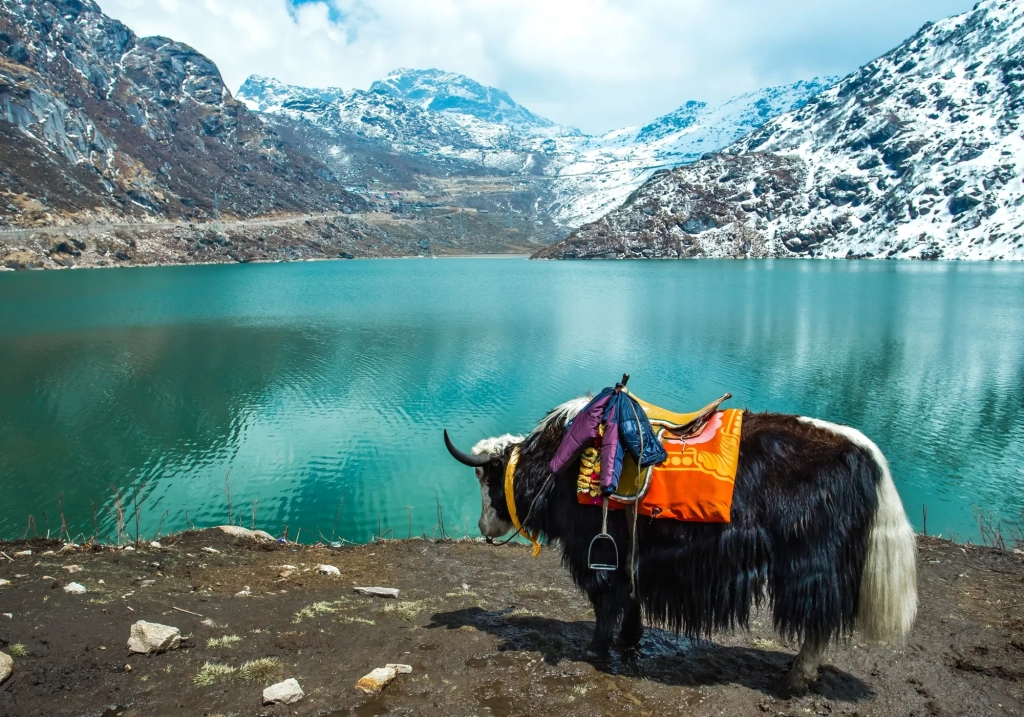
Tsomgo Lake remains frozen during the winter months, presenting a surreal and picturesque sight. During the summer, the lake transforms into a vibrant blue gem, contrasting beautifully with the lush alpine vegetation that surrounds it. Visitors can enjoy activities such as yak rides and snow play in the winter months, while in the summer, the lake becomes a serene spot for boating and picnics. Tsomgo Lake is also a popular stopover for travellers heading to Nathu La Pass, a strategic border crossing between India and China, located nearby.
How to Reach
The most common way to reach Tsomgo Lake is by hiring a local taxi or cab from Gangtok. Taxis are readily available in the city, and most tourists prefer this option. The drive from Gangtok to Tsomgo Lake takes approximately 2 to 3 hours, covering a distance of about 38 kilometers.
Government Buses: Sikkim Nationalized Transport (SNT) buses also operate from Gangtok to Tsomgo Lake. However, the frequency of these buses might be limited, and it is recommended to check the bus schedule in advance.
Nathula Pass: Nathula Pass, located at an elevation of approximately 4,310 meters, is a mountain pass in the Eastern Himalayas that connects the Indian state of Sikkim with the Tibetan Autonomous Region of China. It holds immense strategic and historical significance, being one of the three open trading border posts between India and China.
In the past, Nathula Pass served as a major corridor for trade between India and Tibet. Today, it has become a popular tourist destination, attracting travelers with its breathtaking landscapes, border trade market, and historical artifacts. Visitors can witness the awe-inspiring beauty of the snow-capped Himalayas, including views of the majestic Mount Chomolhari and Mount Jomolhari on the Tibetan side.
Baba Harbhajan Singh Temple: On the way to Nathula Pass, you will come across the Baba Harbhajan Singh Temple, a revered shrine dedicated to a late Indian army soldier. It is a customary stop for visitors to pay their respects.
The pass is accessible to Indian nationals with a special permit, and it remains a symbol of India’s rich cultural ties with Tibet and China.
How to Reach
The pass is about 56 kilometers away from Gangtok, and the journey takes around 2-3 hours, depending on road and weather conditions. The road to Nathula Pass is steep and winding, offering picturesque views of the surrounding mountains.
Zuluk: East Sikkim’s Zuluk, also spelt Dzuluk, is a tranquil and little-known village that is tucked away at a height of about 3,048 metres (10,000 feet) above sea level. It is a charming settlement that attracts curious tourists with its beautiful views of the untamed Himalayan landscape.
The “Zuluk Loops,” a series of charming zigzag roads in Zuluk that are recognised for their thrilling driving experiences and mesmerising views of the surrounding mountains. The village was formerly a crucial stopover on the ancient Silk Road, and signs of this significant trading place. The road journey from Gangtok to Zuluk takes around 4-5 hours, covering a distance of approximately 90 kilometers.
Zemu Glacier: situated in North Sikkim, is one of the largest and longest glaciers in the Eastern Himalayas. The Kanchenjunga range is where the glacier first appears; it has a length of about 26 kilometres. It creates a stunning landscape of ice, snow, and crevasses as it meanders over challenging terrain.
Trekking to Zemu Glacier is a well-liked getaway for nature lovers and adventure seekers. Travellers have the chance to see uncommon flora and fauna in the Himalayas’ high-altitude regions as they trek through secluded and pristine environments.
How to Reach
Gangtok to Lachen: From Gangtok, you need to travel to Lachen, the base village for the Zemu Glacier trek. Lachen is approximately 120 kilometers from Gangtok, and the journey takes around 5-6 hours by road.
Lachen to Zemu Base Camp: The trek to Zemu Glacier starts from Lachen. The trail passes through rugged terrains, dense forests, and remote villages. You will need to trek for several days, camping at different stops along the way, to reach the Zemu Base Camp.
Zemu Base Camp to Zemu Glacier: From the Zemu Base Camp, you need to trek further to reach Zemu Glacier. This part of the trek is more challenging, and you will need to be physically fit and acclimatized to high altitudes.
Phodong Monastery: located in North Sikkim, is an ancient and revered Buddhist monastery that holds significant religious and cultural importance. The monastery features exquisite murals, sacred objects, and statues together with traditional Tibetan-style architecture. The main prayer hall, which is home to a sizable statue of Guru Padmasambhava, the patron saint of Sikkim, is decorated with lovely thangka paintings.
The Phodong Monastery is well known for its exuberant religious rites and festivals that draw both tourists and devotees. A breathtaking sight to behold is the yearly Chaam dance performed by monks at festival occasions.
Rumtek Monastery: Rumtek Monastery, also known as the Dharma Chakra Centre, is one of the most significant and majestic monasteries in Sikkim, India. It is located approximately 23 kilometers from Gangtok. Rumtek Monastery is a prominent seat of the Kagyu school of Tibetan Buddhism. The monastery has outstanding traditional Tibetan architecture, including a golden stupa, multicoloured frescoes, and complex artwork. The main temple, known as “Tsulakhang,” is where priceless Buddhist texts and holy artefacts are kept.
Cafes and Restaurants
- Taste of Tibet: A favourite among locals and tourists, this restaurant offers authentic Tibetan cuisine, including momos, thukpa, and butter tea. Location – Gangtok
- Baker’s Cafe: A charming bakery-cafe offering freshly baked pastries, cakes, and sandwiches, along with a selection of hot and cold beverages. Location – Gangtok
- The Local Cafe: Experience the flavours of Sikkim with traditional Sikkimese dishes like gundruk, phagshapa, and kinema at this cafe. Location – Gangtok
- Nimtho: Serving a mix of Nepali and Sikkimese cuisine, Nimtho is popular for its momos, sel roti, and gundruk soup. Location – Gangtok
- Café Live & Loud: If you’re in the mood for live music and a vibrant atmosphere, this cafe is the place to be. Enjoy good food and live performances. Location – Gangtok
- Rumtek Lounge: situated near Rumtek Monastery, lounge is best known for bakery products and Desserts.
Hotels/Resorts for Stays in Gangtok
Mayfair Spa Resort & Casino: Nestled amidst lush greenery, this resort offers a luxurious retreat with spacious rooms, a rejuvenating spa, and even a casino for entertainment.
Tamarind Residency: A modern and elegant property with well-appointed rooms, offering guests a comfortable and relaxing stay in the heart of Gangtok.
The Elgin Nor-Khill: A heritage gem, this charming hotel boasts traditional architecture, well-furnished rooms, and serene gardens, reflecting Sikkimese culture.
The Royal Plaza: Located conveniently, it offers comfortable rooms with panoramic views, modern amenities, and a rooftop terrace for a delightful dining experience.
Hotel Denzong Regency: Known for its warm hospitality, this hotel features cozy rooms, a restaurant serving local cuisine, and easy access to the main attractions.
Central Hill Resort: A budget-friendly option with a touch of elegance, providing guests with comfortable rooms and a range of amenities.
Popular activities in East Sikkim
Mountain Biking:
Mountain biking in East Sikkim is an exhilarating adventure that allows cyclists to explore the region’s stunning landscapes, charming villages, and rugged terrains. The hilly terrain and scenic beauty of East Sikkim provide an ideal setting for mountain biking enthusiasts.
Gangtok to Hanuman tok is a famous mountain biking route, the bike tour involves going to the top of Hnauman tok and returning back.
Gangtok to Rumtek is a popular biking route that takes cyclists from Gangtok to Rumtek Monastery. The trail passes through quaint villages, lush forests, and offers breathtaking views of the surrounding mountains.
Teesta River Rafting:
One of Sikkim’s most popular rivers rafting locations is the Teesta River. The rafting routes are divided into four classes, Grade I through Grade IV, providing alternatives for different skill levels. The rushing waters of the river and the verdant surroundings make for a wonderful rafting adventure.
The rafting routes vary in length and difficulty, offering options for both beginners and experienced rafters. Some popular routes include Makha – Sirwani, Sirwani – Bardang, and Bardang – 29th Mile, each providing a different rafting experience
Yak Safari:
Take a unique yak safari in places like Tsomgo Lake, yak safari, allows you plenty of time to take in the peaceful atmosphere and admire the area’s natural beauty. It’s essential to follow the guidance of the yak handlers or local guides during the safari to ensure the safety and comfort of both the visitors and the yaks.
Paragliding:
Gangtok offers several spots where tourists and adventure enthusiasts can experience the thrill of paragliding while enjoying panoramic views of the surrounding valleys and mountains.
Baliman Dara – Resithang Village:
This location, which is close to the city, is where the Medium Flight paragliding takes place. It is located at a height of roughly 1,400 metres, and you can get a lovely view of the entire town from there. However, Reshithang Sports Village’s serves as the landing zone.
Bulbery Dara:
“Bulbuley Dara,” also known as “Bulbuley Dara Viewpoint,” is a scenic viewpoint located in Gangtok, Sikkim. The place is famous for high paragliding flights. It takes from 2200 meters. One can view Kanchenjunga and Tashi viewpoint.
Treks
Thambi View Trek:
A short and easy trek, it takes you to the Thambi Viewpoint, providing panoramic views of the Eastern Himalayas and the Teesta River. Difficulty level – easy
Menmecho Lake Trek:
This trek takes you to the pristine Menmecho Lake, surrounded by beautiful rhododendron forests. It is a moderate trek with stunning views of Mt. Kanchenjunga and other peaks. The trek is of 5 kms.
Tarku – Phushrey Lake Trek:
This offbeat trek leads to the enchanting Phushrey Lake, surrounded by rhododendron forests and alpine meadows.
North Sikkim
Gurudongmar Lake: Located at an altitude of 17,800 feet, this sacred lake is one of the highest in the world and offers awe-inspiring views. The lake provides breathtaking views of the magnificent Himalayas and is encircled by gorgeous snow-capped peaks. A beautiful scene is created by its ethereal blue waters and the reflection of the surrounding mountains. Gurudongmar Lake is accessible to visitors during the summer because it is mostly frozen throughout most of the year. Buddhists and the local population place a lot of religious value on it because they think that the water there has healing qualities. Due to its elevation and proximity to the Indo-China border, Gurudongmar Lake requires a special authorization to be visited. Trekking to the lake is an exhilarating and rewarding experience that gives views of the distinctive local flora and fauna.

How to Reach
Once you have the necessary permits, Lachen serves as the base for visiting Gurudongmar Lake. You can reach Lachen by road from Gangtok, the capital city of Sikkim. The road journey from Gangtok to Lachen takes around 6-7 hours.
Restricted Route and Timings: The route from Lachen to Gurudongmar Lake is subject to certain restrictions. Only military-approved vehicles are allowed on this route, and the visit to the lake is time-bound. Tourists usually start early in the morning (around 4-5 AM) from Lachen to reach Gurudongmar Lake. They need to return to Lachen by early afternoon, as the lake area is prone to fast-changing weather and may become inaccessible later in the day.
Yumesamdong: Yumesamdong, also known as Zero Point, is a breathtaking high-altitude destination located in North Sikkim. The landscape at Yumesamdong is unlike anything else, characterized by vast stretches of snow-capped mountains, frozen rivers, and barren, rocky terrain. The air at this altitude feels crisp and pure, offering a sense of serenity and tranquility that is hard to find elsewhere.
Dzongu: A protected area and an offbeat destination, Dzongu is inhabited by the Lepcha community and offers a glimpse of their traditional lifestyle. Native Dzongu residents, the Lepcha people, have retained their rich culture and customs, giving visitors a rare chance to witness their way of life. Traditional Lepcha homes, beautiful cardamom plantations, and terraced fields are all throughout the area. Dzongu provides a variety of hiking trails that take you to breathtaking vistas, cascading waterfalls, and revered lakes. The valley is traversed by the pure Tista River, which presents chances for river rafting.
Lachung: Lachung is a charming mountain village in North Sikkim that is well-known for its breathtaking scenery, alpine meadows, and tranquil atmosphere. At a height of about 2,900 metres, it provides the ideal hideaway in the midst of the Eastern Himalayas. Lachung is famous for the Lachung Chu River, which runs through the community, and the stunning Yumthang Valley, often known as the “Valley of Flowers.” The valley is covered in vivid rhododendron flowers in the spring, which produces a kaleidoscope of hues. The settlement provides a starting point for visiting Yumthang Valley, as well as the close-by Katao and Zero Point, which provide stunning views of snow-covered peaks and glacier landscapes.
Yumthang Valley: A stunningly gorgeous alpine valley, Yumthang Valley, is located in North Sikkim at an elevation of roughly 3,564 metres. It is recognised for its breathtakingly beautiful natural surroundings, lively meadows, and varied flora. As a result of the abundance of wildflowers that bloom in the spring, Yumthang Valley is transformed into a paradise of colour. The valley is a botanist’s paradise because it is covered in a variety of rhododendron varieties. Yumthang is surrounded by snow-capped mountains and sparkling streams in addition to its floral splendour, which adds to its beautiful appeal. The area is particularly well-known for its hot springs, which provide a peaceful escape from the frigid weather.
How to Reach
The most common way to reach Yumthang Valley is a private vehicle from Lachung, a village located approximately 25 kilometers away from the valley. Lachung serves as the base for visiting Yumthang Valley. You can reach Lachung by road from Gangtok, the capital city of Sikkim. The road journey from Gangtok to Lachung takes around 5-6 hours.
Lachen: Lachen is a picturesque and remote village located in North Sikkim, India. Situated at an elevation of approximately 2,750 meters, the place serves as a base for several breathtaking treks and adventures in the region. The village is surrounded by mesmerizing landscapes, with snow-capped peaks, pristine lakes, and lush alpine forests, making it a paradise for nature enthusiasts and photographers. Lachen is renowned for being the starting point for the trek to Gurudongmar Lake, one of the highest lakes in the world and a sacred site for both Buddhists and Sikhs. The lake’s sparkling waters and the surrounding rugged mountains offer a surreal and unforgettable experience. Another popular attraction near Lachen is Chopta Valley, known for its blooming rhododendron forests during the spring season, creating a colourful spectacle. The village provides a glimpse into the local culture and lifestyle, with charming wooden houses and warm hospitality of the local residents.
Kanchenjunga National Park: The third-highest peak in the world, Mount Kanchenjunga, which towers magnificently inside the park’s boundaries, inspired the park’s naming in 1977. The park’s expansive 849 square kilometre territory, which is made up of rocky hilly terrain, deep valleys, alpine meadows, and dense temperate woods, are what make it so unique. It is home to a wide range of plants and fauna, many of which are uncommon or endangered. With opportunities to see rare animals like the red panda, snow leopard, Himalayan tahr, musk deer, and various species of vibrant birds, the park is a refuge for nature lovers and wildlife aficionados.
Kanchenjunga National Park also presents trekking enthusiasts with the thrilling and challenging Kanchenjunga Base Camp trek, allowing adventurers to witness stunning vistas of the Kanchenjunga massif and the surrounding Himalayan peaks.
How to Reach
By Air: The nearest airport to Kanchenjunga National Park is Bagdogra Airport in the neighboring state of West Bengal. Bagdogra Airport is well-connected to major cities in India. From the airport, you can hire a taxi or take a pre-paid taxi service to reach Gangtok, the capital city of Sikkim.
By Train: The nearest major railway station to Kanchenjunga National Park is New Jalpaiguri Railway Station (NJP) in West Bengal. NJP is well-connected to various cities across India. From New Jalpaiguri Railway Station, you can hire a taxi or take a shared jeep to reach Gangtok.
By Road: Gangtok serves as the gateway to Kanchenjunga National Park. From Gangtok, you can take a taxi or shared jeep to reach Yuksom, the starting point for the popular trek to Dzongri and Goecha La. The road journey from Gangtok to Yuksom takes around 5-6 hours, covering a distance of approximately 120 kilometers.
Trekking: From Yuksom, you need to undertake a trek to reach the core areas of Kanchenjunga National Park. The most popular treks are the Dzongri and Goecha La treks, which offer breathtaking views of Mount Kanchenjunga and surrounding peaks. These treks require proper planning, permits, and a registered guide. The trek to Dzongri usually takes around 4-5 days, and the Goecha La trek takes about 8-9 days.
Mount Katao: In North Sikkim, close to the town of Lachung, sits Mount Katao, also known as Katao summit, a stunning and lesser-known high summit. At almost 4,572 metres above sea level, it provides breathtaking panoramic views of the snow-covered Himalayas and the neighbouring valleys. Trekkers and nature lovers looking for a unique and adventurous experience frequently visit Mount Katao because of its captivating beauty and unspoiled scenery. The area is frequently blanketed with snow, which creates a mystical and serene atmosphere, especially in the winter. Snow trekking, skiing, and snowboarding are among the activities available to visitors, making it a winter wonderland for adventurers. Due to its remote location and harsh weather conditions, access to Mount Katao is limited, and travellers require a special permit to visit the area.
Tso Lhamo Lake: also known as Cholamu Lake, is a high-altitude glacial lake situated at an elevation of approximately 5,334 meters in North Sikkim, India. It is recognized as one of the highest lakes in the world and is located near the Tibetan border. Due to its proximity to the border and the sensitive military area, access to Tso Lhamo Lake is restricted, and special permits are required to visit the region.
The lake is surrounded by stunning snow-capped peaks and offers breathtaking views of the Eastern Himalayas. It remains frozen for most of the year, with the ice covering the lake’s surface even during the summer months. Tso Lhamo Lake holds significant religious importance for the local communities, and it is considered a sacred site. It is often visited by pilgrims and spiritual seekers who believe that a dip in its cold waters brings blessings and spiritual purification. The journey to Tso Lhamo Lake involves a challenging and adventurous drive through rugged terrains, adding to the allure of this remote and pristine destination.
How to Reach
Lachen serves as the base for visiting Tso Lhamo Lake. You can reach Lachen by road from Gangtok. The road journey from Gangtok to Lachen takes around 6-7 hours.
Cafes and Restaurants
- Malaun Café: located in thangu valley, the café is a popular one northern Sikkim.
- Yumthang Cafeteria cum resort and Camping: situated near Yumthan valley, the cafeteria is famous with tourists, providing a serene atmosphere and delicious food options.
- Ingredient Resto-Bar: situated in lachen market, the restro bar offers local cuisine and beverages, the local wine named Tongba is well liked by tourists.
- Tso Lhamo restaurant and bar: located in Lachen, one can expect high quality service with variety of food options. The place offers local to north Indian cuisines.
- Shambala Fast Food: located in Gurudongmar Road, Lachen, the place is best known for its momos.
Hotels and Stays
Yarlam Resort Lachung: A popular choice, this resort offers comfortable rooms, hot water facilities, and breathtaking views of the surrounding mountains.
Delight Hotels Royal Lachung: Known for its friendly staff and hospitality, this hotel provides cozy accommodations and warm meals to make your stay pleasant.
Apple Valley Inn: Offers a range of rooms, warm service, and proximity to the beautiful natural surroundings.
The Fortuna Lachung: A simple and budget-friendly option providing essential amenities and a convenient location.
Yumthang Valley Resort: While not directly in the valley, it’s a notable mention. It’s situated in the region and provides guests with a rustic experience amidst the beauty of nature.
Kanchenjunga Mountain View Homestays: Located in areas like Pelling, these homestays provide a local experience with stunning views of the Kanchenjunga range.
Adventure Activities in North Sikkim
Kanchenjunga Base Camp Trek: This challenging trek leads to the Kanchenjunga Base Camp, offering close-up views of the world’s third-highest peak, Mt. Kanchenjunga. The trek can be stretched to 11 days and can lead up to the distance of 90 kms. The trek is considered moderate to difficult. The trek starts and ends at Yuksom.
The Green Lake: The Green Lake Trek is an adventurous and challenging trek that takes trekkers to the pristine and remote Green Lake, situated at the base of the majestic Mount Kanchenjunga. The trek usually starts from the picturesque village of Lachen, located in North Sikkim. The Green Lake Trek is considered one of the challenging treks in Sikkim and requires good physical fitness. It usually takes around 10 to 14 days to complete the Green Lake Trek. As the trek passes through restricted areas, obtaining permits from the Sikkim tourism authorities is necessary before embarking on the Green Lake Trek.
Yumthang Hot Spring: Yumthang Hot Spring is a natural hot water spring located in the enchanting Yumthang Valley. The hot spring is believed to have therapeutic and medicinal properties due to its mineral-rich water, making it a favorite spot for locals and tourists seeking relief from various ailments.
Dzongri Trek: The Dzongri Trek typically begins from the charming village of Yuksom in West Sikkim, which served as the first capital of Sikkim. The Dzongri Trek is considered a moderate-level trek, suitable for both beginners and experienced trekkers. The Dzongri Trek usually takes around 5 to 6 days to complete. As the trek falls within the Kanchenjunga National Park, trekkers need to obtain necessary permits from the Sikkim tourism authorities.
Jhang Lhari Nyingphug Cave: Jhang Lhari Nyingphug is a remote and lesser-known cave located in North Sikkim, near the border with Tibet. The place has seven caves and is considered the holiest of caves in Sikkim. The route to the caves is a hard one and takes a hard trek of 3 from Gurung Gaon. You have to carry items like sleeping bags, clothes and cooking items.
South Sikkim
Ravangla: A peaceful town known for its beautiful Buddha Park, offering panoramic views of the mountains. The stately Ralang Monastery, also known as the Palchen Choeling Monastic Institute, is the town’s most well-known landmark and a prominent place of worship for Tibetan Buddhism’s Kagyu lineage. The monastery is a must-visit location for spiritual searchers since it contains holy texts, elaborate murals, and religious artefacts. The famous Buddha Park, also known as Tathagata Tsal, is located in Ravangla. The park is home to a massive statue of Lord Buddha that is 40 metres tall and offers captivating panoramic views of the surrounding area.
Trekking, birdwatching, and paragliding are among the adventure sports available, while the Maenam Hill and the surrounding Menam Wildlife Sanctuary provide fantastic chances for exploration.
How to reach:
The road journey from Gangtok takes around 3-4 hours, covering a distance of approximately 70 kilometers.
Namchi: The word “Namchi” means “Sky High” in the regional language, which appropriately captures the location’s lofty setting among the hills. The town is well-known for the 130-foot-tall statue of Guru Rinpoche, also known as Guru Padmasambhava, that can be found atop Samdruptse Hill. This enormous monument is a well-known landmark and provides expansive views of the nearby mountains and valleys.
The Char Dham, a religious complex that resembles the four most important pilgrimage destinations in India (Badrinath, Puri, Dwarka, and Rameswaram), is also located in Namchi. Numerous devotees and travellers looking for blessings and spiritual comfort flock to this holy place.
How to reach
The road journey from Gangtok takes around 2-3 hours, covering a distance of approximately 78 kilometers.
Namchi is also accessible from other nearby towns and tourist destinations in Sikkim. You can take a taxi or shared jeep from Pelling, Ravangla, or Jorethang to reach Namchi.
Tendong Hill: Tendong Hill is a beautiful hill located in South Sikkim, near the town of Ravangla. It is renowned for both its historical importance and its beautiful views of the nearby mountains and valleys. Folklore in the area holds that Tendong Hill was the location where Sikkim’s whole population sought safety during a disastrous flood in antiquity.
Temi Tea Garden: The sole tea plantation in the state and one of India’s most scenic tea gardens is Temi Tea Garden, is situated in the southern portion of Sikkim. Temi Tea Garden, which extends across the mild Himalayan slopes at a height of roughly 1,676 metres, provides breathtaking views of the surrounding scenery and the magnificent Kanchenjunga range. The Temi Orthodox Tea, which is well-known throughout the world, is one of the premium teas produced in the garden. It was founded in 1969, is run by the Sikkim government, and uses organic agricultural methods, making it a distinctive and environmentally friendly tea estate. To understand more about the tea-making process, from picking the tea leaves to processing them, visitors to Temi Tea Garden can join guided tours.
The Rose Park: A wonderful botanical park in Namchi, South Sikkim, is well-known for its substantial collection of roses and other vibrant blooms. The garden, which is spread out over a considerable area, provides a pleasant haven amidst the tranquil Himalayan surroundings. A large range of roses in all hues, forms, and sizes may be found in the Rose Garden, making for an eye-catching and fragrant show. It is a haven for lovers of the outdoors and flowers since visitors may wander along well-kept paths while being surrounded by an abundance of flowering roses.
Buddha Park: The Buddha Park of Ravangla, also known as Tathagata Tsal, is a mesmerizing Buddhist Park and pilgrimage center situated in Ravangla, South Sikkim. This serene park is dedicated to Lord Buddha and features an impressive 130-foot (40-meter) tall statue of the Buddha, surrounded by beautifully landscaped gardens and panoramic views of the Eastern Himalayas.
The giant statue of Buddha is one of the tallest in India and stands as a symbol of peace, compassion, and spiritual enlightenment. The serene facial expression and the golden hue of the statue add to its majestic presence. Visitors to the Buddha Park can circumambulate around the statue, offering prayers and seeking blessings. The park also provides ample spaces for meditation and quiet contemplation. Apart from the Buddha statue, the park houses smaller statues of bodhisattvas and religious symbols, creating a serene and spiritually uplifting atmosphere. The panoramic views from the Buddha Park are especially stunning during sunrise and sunset, offering a breathtaking vista of the surrounding mountains and the verdant valleys.
Maenam Wildlife: South Sikkim’s Maenam Wildlife sanctuary is a biodiverse refuge renowned for its varied flora and animals. The sanctuary is called after Maenam Hill, which is the highest point in the area and provides breathtaking views of the Himalayan peaks. It is a 36 square kilometre area. A broad range of plant species, including different varieties of rhododendrons, orchids, and medicinal plants, can be found within the sanctuary. A variety of animals, such as the red panda, Himalayan black bear, leopard cat, barking deer, and other bird species, can be found in the deep forests.
How to reach:
By Road: Maenam Wildlife Sanctuary is accessible by road from Gangtok. You can take a taxi or a shared jeep from Gangtok to reach the base of the sanctuary. The road journey takes around 45 minutes to 1 hour, covering a distance of approximately 25 kilometers.
Trekking: From the base of Maenam Wildlife Sanctuary, you need to undertake a trek to reach the core areas of the sanctuary. The trek to Maenam Hilltop is moderate and takes around 3-4 hours, depending on your pace. The trail passes through dense forests and offers stunning views of the surrounding mountains and valleys.
Adventurous activities in South Sikkim
River Rafting in Melli: River rafting in Melli is a family-friendly adventure, and experienced rafting guides ensure safety and provide instructions for an enjoyable experience. Rafting on the Teesta River allows participants to enjoy the breathtaking landscapes of the Eastern Himalayas, with lush greenery, terraced fields, and picturesque villages lining the riverbanks. River rafting sessions in Melli typically range from one to three hours, depending on the stretch chosen and the rafting package selected.
River rafting at 29th Mile: The Teesta River at 29th Mile provides an exhilarating river rafting experience with various rapids ranging from Grade II to Grade IV. This makes it suitable for both beginners and experienced rafters. The duration of river rafting sessions at 29th Mile can vary based on the stretch chosen and the rafting package selected, typically ranging from one to three hours.
Cave Exploration: Sharchog Bey Phug, also known as Bey Phug Cave or Sharchog Beyphug Cave, is a sacred and ancient cave located near Namchi in South Sikkim. Guru Padmasambhava (Guru Rinpoche), a respected Buddhist guru who was instrumental in bringing Buddhism to the Himalayan region, is linked to Sharchog Bey Phug. The cave is thought to have served as Guru Rinpoche’s refuge and place of meditation while he was in Sikkim. Sharchog Bey Phug attracts pilgrims and practitioners of Buddhism who come here to meditate, seek blessings, and connect with the spiritual essence of the place.
Namchi-Char Dham Cable Car ride: The cable car ride takes approximately 20 to 30 minutes, offering a leisurely and enjoyable experience. The cable car ride offers ample opportunities for photography, allowing visitors to capture the beauty of the landscape from a unique vantage point.
Cafes and Restaurants
- Flavours Restaurant: located in Namchi, the restaurant offers variety of foods and the cocktail options are popular among tourists.
- Clouds End Retreat & Café: situated in Ravangla the retreat along with 4 start hotel offers interesting dining options.
- Buddha Retreat: located near the Buddha Park of Ravangla, this cafe offers stunning view and serves refreshments and snacks.
- Roll Corner: located inside Buddha Park, the restaurant offers variety of vegetarian food options.
- Taste Of Sikkim: located in Ralong road, taste of Sikkim offers local cuisine with great ambience. If you are looking for vegetarian meals then taste of Sikkim is the place for you.
Hotels and Resorts for Stay
Summit Sobralia Resort & Spa: A luxurious resort with well-appointed rooms, spa facilities, and stunning views of the surrounding mountains.
Yangthang Dzimkha Resort: Offers a blend of luxury and traditional charm, providing a serene and elegant stay.
Summit Golden Crescent Resort & Spa: A luxurious property offering spacious rooms, spa facilities, and breathtaking views of the Himalayas.
The Lindsay Himalayan Heights: Known for its opulent rooms, panoramic views, and exceptional service.
The Hill Castle: Offers a blend of luxury and comfort, with modern amenities and a refined atmosphere.
West Sikkim
Pelling: This quaint town offers panoramic views of Mt. Kanchenjunga and is home to the revered Pemayangtse Monastery. The town is a good starting point for visiting a number of the region’s sights, including the historically significant Pemayangtse Monastery. The monastery, which was established in the 17th century and features excellent paintings and sculptures, is a well-known place of worship in Sikkim.
Pelling also provides guests with expansive views of the surrounding hills and the tranquil Rimbi Waterfall, where they may go on hikes and have picnics. Another noteworthy place to go is the neighboring Khecheopalri Lake, which is revered and thought to grant wishes. Adventurers have the chance to explore the adjacent Singalila Ridge and the well-known Dzongri-Goecha La Trek, as well as engage in activities like rock climbing and trekking.
How to reach:
Major cities and towns in Sikkim and surrounding regions can be reached by road and reach Pelling with ease. From Gangtok, the Sikkim state capital, you can go to Pelling by taxi or shared jeep. Road travel from Gangtok covers a distance of about 116 kilometres and takes about 4-5 hours.
Pemayangtse Monastery: One of the most important and historic monasteries in the state is Pemayangtse Monastery, which is situated in Pelling, West Sikkim. The name “Pemayangtse” means “Perfect Sublime Lotus” in the native tongue, which reflects the monastery’s spiritual importance. It is regarded as a prime example of traditional Tibetan workmanship due to its age-old construction, elaborate woodwork, and bright paintings. The three-story wooden building, known as “Zangdog Palri,” which displays numerous religious artefacts, thangka paintings, and sculptures, is Pemayangtse Monastery’s main draw. The seven-tiered painted wooden edifice symbolises Guru Padmasambhava’s heavenly residence.
The Rabdentse Ruins: located near Pelling in West Sikkim, are the remnants of an ancient and historically significant capital of the former Kingdom of Sikkim. Rabdentse served as the second capital of Sikkim from the late 17th century until the early 19th century when it was abandoned. The ruins are nestled amidst lush forests and offer a serene and tranquil setting, making it a popular attraction for history enthusiasts and nature lovers alike.
Visitors to the Rabdentse Ruins can explore the remnants of the royal palace, ancient monasteries, and other architectural structures that once thrived in the region. The site provides an opportunity to delve into the rich history and culture of the Sikkimese people. The ruins are a UNESCO World Heritage Site, recognized for their historical significance and architectural heritage. The location of the Rabdentse Ruins, with stunning views of the Kanchenjunga range and the surrounding valleys, adds to the allure of this ancient site.
Kanchenjunga Waterfalls: In West Sikkim, India, close to Pelling, there is a stunning waterfall called Kanchenjunga Falls, often referred to as Kanchenjunga Waterfalls. It is one of the most well-known waterfalls in the area and provides a beautiful spectacle as the water cascades down from a substantial height through the lush Himalayan jungle. The majestic Mount Kanchenjunga, the third-highest peak in the world, which is visible from many locations in the region, including the waterfall, is the inspiration for the name of the falls.
The popular rest point for tourists visiting Pelling and other local sights is Kanchenjunga Falls. It’s the perfect location for picnics, relaxation, and photography because of the rushing waters and the stunning scenery nearby.
Yuksom: West Sikkim’s Yuksom is a picturesque and historic town renowned for its extensive cultural legacy and magnificent natural beauty. Since it served as the first capital of the former Kingdom of Sikkim, it has enormous historical value. A haven for hikers and environment lovers, the town is surrounded by verdant forests, bubbling streams, and snow-capped mountains. The Dubdi Monastery is one of Yuksom’s main draws. It was founded in 1701 and is one of Sikkim’s oldest monasteries as well as a significant Buddhist pilgrimage destination. Yuksom is the starting point for a number of trekking routes, including the well-known Kanchenjunga Base Camp trip, giving hikers the chance to discover the untainted grandeur of the Eastern Himalayas. The road journey from Gangtok takes around 6-7 hours, covering a distance of approximately 140 kilometers.
Khecheopalri Lake: also known as Khecheopalri Sacred Lake, is a sacred and serene lake located in West Sikkim, India. Situated at an altitude of approximately 1,829 meters, it is considered one of the holiest lakes in Sikkim and is revered by both Buddhists and Hindus.
The lake is surrounded by lush green forests and offers a peaceful and picturesque setting. According to local beliefs, the lake is blessed and has the power to fulfill wishes. As a result, visitors often make offerings in the form of prayer flags and stones near the lake. Khecheopalri Lake is also known for its unique ecological balance. Despite being surrounded by dense forests, the surface of the lake remains remarkably clean and free from fallen leaves, as the birds quickly pick them up.
Limboo Cultural Museum: Learn about the Limboo community’s culture and heritage at the Limboo Cultural Museum in Bermiok. Limboo Heritage and Research Centre, is a museum dedicated to preserving and showcasing the cultural heritage of the Limboo community. The museum’s location in the serene town of Bermiok adds to the overall cultural experience, providing a peaceful environment to explore Limboo culture.
Goech La trek: One of the famous and sought-after treks in Sikkim, India, is the Goecha La Trek. This challenging walk gives stunning views of Mount Kanchenjunga, the third-highest mountain in the world, and leads you deep into the captivating Kanchenjunga National Park. As the trek passes through Kanchenjunga National Park, trekkers need to obtain permits from the authorities in Yuksom.
Yusksom Bazar: One of the busiest streets in West Sikkim, the bazar is famous for its hand-crafted items. There are several monasteries in and around Yuksom, including Dubdi Monastery, which is considered one of the oldest monasteries in Sikkim and offers stunning views of the Himalayas. Many trekkers and travellers use Yuksom Bazar as a peaceful retreat to rejuvenate before or after their trekking expeditions.
Mountain Biking: Yuksom-Kheochepari, the biking tour starts from the morning and takes you through major attractions such as Khecheopalri Lake, Kangchendzonga National Park, and much more. The tour covers 25 kms of distance.
Cafes and Restaurants
- Golden Ice (Pelling): A popular cafe in Pelling known for its delicious snacks, hot beverages, and beautiful views of the surrounding mountains.
- Maggi Point (Pelling): A popular spot to savor the famous Indian noodle snack “Maggi” amidst picturesque surrounding. The point is situated in Kanchenjunga falls main point the place is easily accessible at a walking distance.
- Gupta Restaurant: situated in Yuksom the restaurant is the most famous restaurant in Yuksom. The place offers delicious local as well as north Indian food. Local cuisine such as Tibetan bread and honey tea is a must try.
- Dokohthang: situated in Naku, the place provides food options with The food provided is home cooked and home grown, giving authentic taste of Sikkim.
- Bhansa Ghar: situated in pelling, Bhansa ghar is a cozy restaurant the place is famous for its Tibetan and Chinese cuisines.
Hotels and Stays
The Elgin Mount Pandim, Pelling: A luxury option offering comfortable rooms, beautiful gardens, and panoramic views of the mountains.
Hotel Dubdi, Pelling: Provides cozy rooms, warm hospitality, and proximity to Pelling’s attractions.
Summit Newa Regency, Pelling: Known for its serene ambiance and mountain views, this hotel offers a comfortable stay.
The Chumbi Mountain Retreat & Spa, Pelling: Offers a luxurious experience with well-appointed rooms, spa facilities, and mountain vistas.
Hotel Golden Sunrise and Spa, Pelling: Known for its excellent views and well-maintained rooms, this hotel offers a comfortable stay.
Tashigang Resort: Offers comfortable rooms and a tranquil setting, allowing you to enjoy the natural beauty of the area.
Mount Narsing Village Resort: Known for its warm hospitality and beautiful location, providing a peaceful stay.
Red Panda Hotel: Offers basic amenities and a convenient location for exploring Yuksom.
Hotel Tashi Gang: A budget-friendly option providing essential facilities and easy access to the village.
Yatri Niwas: A simple and affordable stay, offering a base for treks and exploration.
Limboo Homestay: Experience local culture with a homestay option, offering a chance to connect with the locals.
Offbeat Gateaways and Treks in Sikkim
Borong: Borong is a serene and lesser-known village located in South Sikkim. The hot springs in Borong, also known as Borong Tsa-Chu, are among the city’s top draws. Both locals and visitors seek rest and rejuvenation in the natural hot springs, which are thought to have therapeutic qualities. The community is surrounded by verdant woodlands, terraced fields, and sparkling streams, which creates a hypnotic and invigorating atmosphere. With opportunities to see a variety of Himalayan bird species, it is a fantastic location for nature walks and birding. Borong’s attractiveness is enhanced by the breathtaking vistas it offers of the Rangit River and far-off snow-capped peaks. The village is mostly unaffected by mass tourism, giving tourists the chance to encounter genuine Sikkimese hospitality and culture.
How to reach
By Road: Borong is accessible by road from major cities and towns in Sikkim and neighboring states. If you are traveling from Gangtok or other parts of Sikkim, you can hire a taxi or take a shared jeep from these locations to reach Borong. The road journey from Gangtok to Borong may take around 4-5 hours, depending on the weather and road conditions.
Ravangla to Borong: If you are coming from Ravangla, Borong is approximately 17 kilometers away. You can hire a taxi or take a local bus from Ravangla to reach Borong.
Pelling to Borong: If you are coming from Pelling, Borong is approximately 33 kilometers away. You can hire a private vehicle from Pelling to reach Borong.
Uttarey: The village is located on the famous Singalila Ridge trek route, making it a popular stopover for trekkers. The Singalila Ridge offers panoramic views of the world’s highest mountains, including Mt. Everest and Mt. Kanchenjunga, making it a dream destination for nature and adventure enthusiasts.
By Road: Uttarey is accessible by road from major cities and towns in Sikkim and neighboring states. If you are traveling from Gangtok, Pelling, or other parts of Sikkim, you can take a shared jeep from these locations to reach Uttarey. The road journey from Gangtok to Uttarey may take around 6-7 hours, depending on the weather and road conditions.
Rinchenpong: Rinchenpong is a serene and scenic village located in West Sikkim, India. Perched at an altitude of approximately 1,676 meters, it offers breathtaking views of the majestic Kanchenjunga range and the surrounding Eastern Himalayas. Rinchenpong also offers stunning views of the Rangit River and the Singalila Range, making it a favourite destination for photographers and nature enthusiasts. For travellers seeking an offbeat and authentic experience in the lap of the Himalayas, Rinchenpong stands as a hidden gem, promising a serene and unforgettable journey amidst the untouched beauty of the Eastern Himalayas.
Rinchenpong is accessible by road from major cities and towns in Sikkim and neighboring states. If you are traveling from Gangtok or other parts of Sikkim, you can hire a taxi or take a shared jeep from these locations to reach Rinchenpong. The road journey from Gangtok to Rinchenpong may take around 4-5 hours, depending on the weather and road conditions.
Pelling to Rinchenpong: If you are coming from Pelling, Rinchenpong is approximately 30 kilometers away. You can hire a taxi or take a local bus from Pelling to reach Rinchenpong.
Siliguri to Rinchenpong: If you are coming from Siliguri, you can take the route via Jorethang and Legship to reach Rinchenpong. The road journey from Siliguri to Rinchenpong may take around 4-5 hours.
Chalamthang: Chalamthang is recognised for its stunning scenery, verdant surroundings, and peaceful atmosphere. Travellers looking for a tranquil vacation amidst Sikkim’s natural splendour should definitely consider this off-the-beaten-path location. Close to Chalamthang, you can visit the Kyongnosla Alpine Sanctuary, which is known for its stunning rhododendron blooms during the flowering season.
Pelling to Chalamthang: If you are coming from Pelling, Chalamthang is approximately 65 kilometers away. You can take a private vehicle from Pelling to reach Chalamthang.
Ravangla to Chalamthang: If you are coming from Ravangla, Chalamthang is approximately 40 kilometers away.
Kabi Longstok: The Kabi Lungchok, a historical pillar built to honour the agreement between the Lepchas and the Tibetans, is what makes Kabi Longstok famous. For the Sikkimese, the location is revered and important to their culture.
